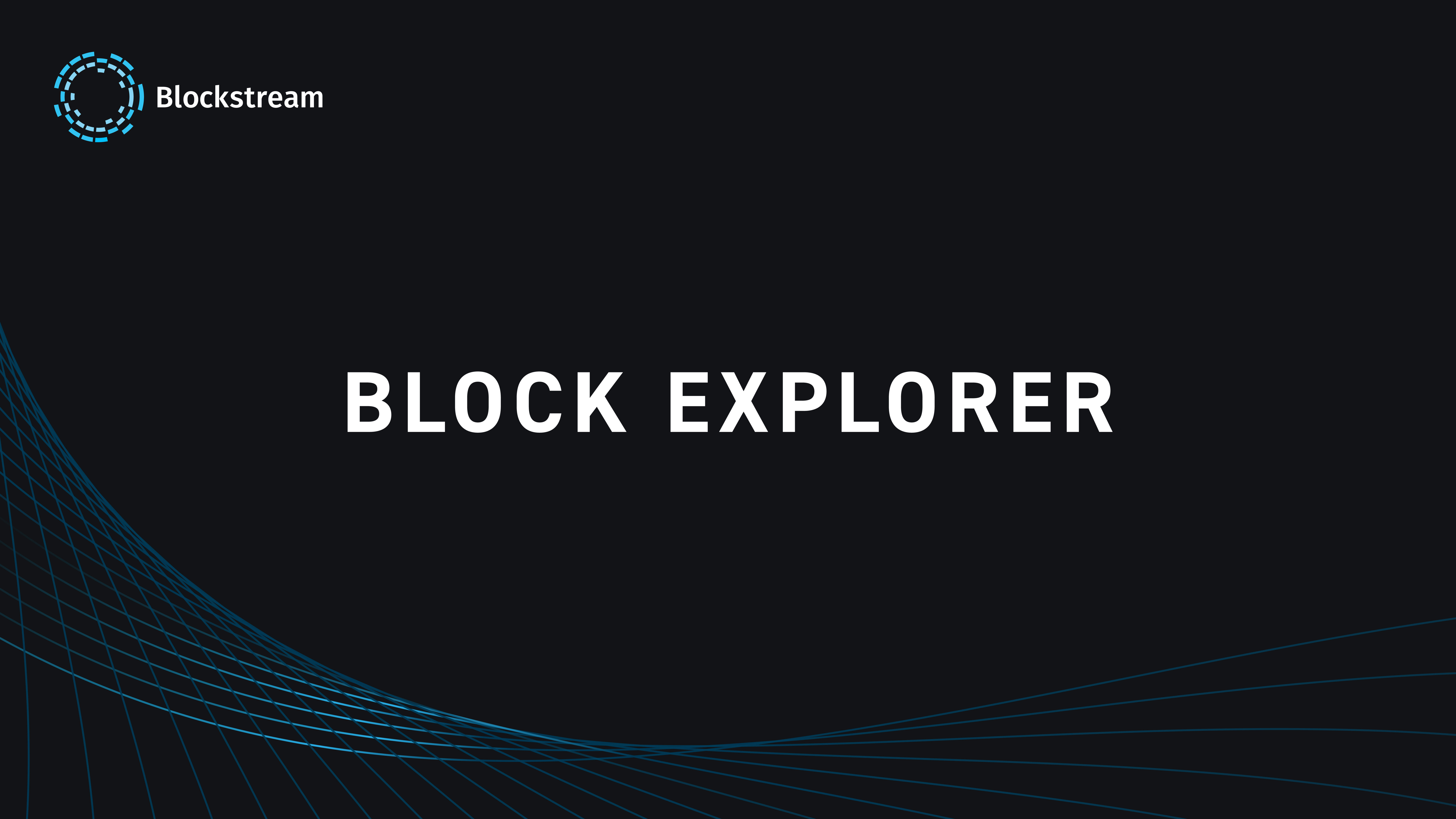Block explorer web interface based on the esplora-electrs HTTP API.
Written as a single-page app in a reactive and functional style using rxjs and cycle.js.
See live at Blockstream.info.
API documentation is available here.
Join the translation efforts on Transifex.
-
Explore blocks, transactions and addresses
-
Support for Segwit and Bech32 addresses
-
Shows previous output and spending transaction details
-
Quick-search for txid, address, block hash or height by navigating to
/<query> -
Advanced view with script hex/assembly, witness data, outpoints and more
-
Mobile-ready responsive design
-
Translated to 17 languages
-
Light and dark themes
-
Noscript support
-
For Liquid and other Elements-based chains: support for CT, peg-in/out transactions and multi-asset
To start a development server with live babel/browserify transpilation, run:
$ git clone https://github.com/Blockstream/esplora && cd esplora
$ npm install
$ export API_URL=http://localhost:3000/ # or https://blockstream.info/api/ if you don't have a local API server
# (see more config options below)
$ npm run dev-serverThe server will be available at http://localhost:5000/
To build the static assets directory for production deployment, set config options (see below)
and run $ npm run dist. The files will be created under dist/.
Because Esplora is a single-page app, the HTTP server needs to be configured to serve the index.html file in reply to missing pages.
See contrib/nginx.conf.in for example nginx configuration (TL;DR: try_files $uri /index.html).
To start a pre-rendering server that generates static HTML replies suitable for noscript users, run:
# (clone, cd, "npm install" and configure as above)
$ export STATIC_ROOT=http://localhost:5000/ # for loading CSS, images and fonts
$ npm run prerender-serverThe server will be available at http://localhost:5001/
All options are optional.
NODE_ENV- set toproductionto enable js minification, or todevelopmentto disable (defaults toproduction)BASE_HREF- base href for user interface (defaults to/, change if not served from the root directory)STATIC_ROOT- root for static assets (defaults toBASE_HREF, change to load static assets from a different server)API_URL- URL for HTTP REST API (defaults to/api, change if the API is available elsewhere)CANONICAL_URL- absolute base url for user interface (optional, only required for opensearch and canonical link tags)NATIVE_ASSET_LABEL- the name of the network native asset (defaults toBTC)SITE_TITLE- website title for<title>(defaults toBlock Explorer)SITE_DESC- meta description (defaults toEsplora Block Explorer)HOME_TITLE- text for homepage title (defaults toSITE_TITLE)SITE_FOOTER- text for page footer (defaults toPowered by esplora)HEAD_HTML- custom html to inject at the end of<head>FOOT_HTML- custom html to inject at the end of<body>CUSTOM_ASSETS- space separated list of static assets to add to the buildCUSTOM_CSS- space separated list of css files to append intostyle.cssNOSCRIPT_REDIR- redirect noscript users to{request_path}?nojs(should be captured server-side and redirected to the prerender server, also seePRERENDER_URLin dev server options)
Elements-only configuration:
NATIVE_ASSET_ID- the ID of the native asset used to pay fees (defaults to6f0279e9ed041c3d710a9f57d0c02928416460c4b722ae3457a11eec381c526d, the asset id for BTC)BLIND_PREFIX- the base58 address prefix byte used for confidential addresses (defaults to12)PARENT_CHAIN_EXPLORER_TXOUT- URL format for linking to transaction outputs on the parent chain, with{txid}and{vout}as placeholders. Example:https://blockstream.info/tx/{txid}#output:{vout}PARENT_CHAIN_EXPLORER_ADDRESS- URL format for linking to addresses on parent chain, with{addr}replaced by the address. Example:https://blockstream.info/address/{addr}MANDATORY_SEGWIT- set to1to indicate segwit is not an optional featureASSET_ISSUANCE- set to1to enable support for issued assetsASSET_MAP_URL- url to load json asset map (in the "minimal" format)
Menu configuration (useful for inter-linking multiple instances on different networks):
MENU_ITEMS- json map of menu items, where the key is the label and the value is the urlMENU_ACTIVE- the active menu item identified by its label
All GUI options, plus:
PORT- port to bind http development server (defaults to5000)CORS_ALLOW- value to set forAccess-Control-Allow-Originheader (optional)PRERENDER_URL- base url for prerender server, for redirecting?nojsrequests (should be set alongsideNOSCRIPT_REDIR)
All GUI options, plus:
PORT- port to bind pre-rendering server (defaults to5001)
docker build -t esplora .
docker run -p 8080:80 \
--volume $PWD/data_bitcoin_mainnet:/data \
--rm -i -t esplora \
bash -c "/srv/explorer/run.sh bitcoin-mainnet explorer"
docker run -p 8082:80 \
--volume $PWD/data_liquid_mainnet:/data \
--rm -i -t esplora \
bash -c "/srv/explorer/run.sh liquid-mainnet explorer"
docker run -p 8084:80 \
--volume $PWD/data_bitcoin_testnet:/data \
--rm -i -t esplora \
bash -c "/srv/explorer/run.sh bitcoin-testnet explorer"
docker build -t blockstream/esplora-base:latest -f Dockerfile.deps .
docker push blockstream/esplora-base:latest
docker inspect --format='{{index .RepoDigests 0}}' blockstream/esplora-base
docker build --squash -t blockstream/gcloud-docker:latest -f Dockerfile.ci .
docker push blockstream/gcloud-docker:latest
docker inspect --format='{{index .RepoDigests 0}}' blockstream/gcloud-docker
docker build --squash -t blockstream/gcloud-tor:latest -f Dockerfile.tor .
docker push blockstream/gcloud-tor:latest
docker inspect --format='{{index .RepoDigests 0}}' blockstream/gcloud-tor
MIT




